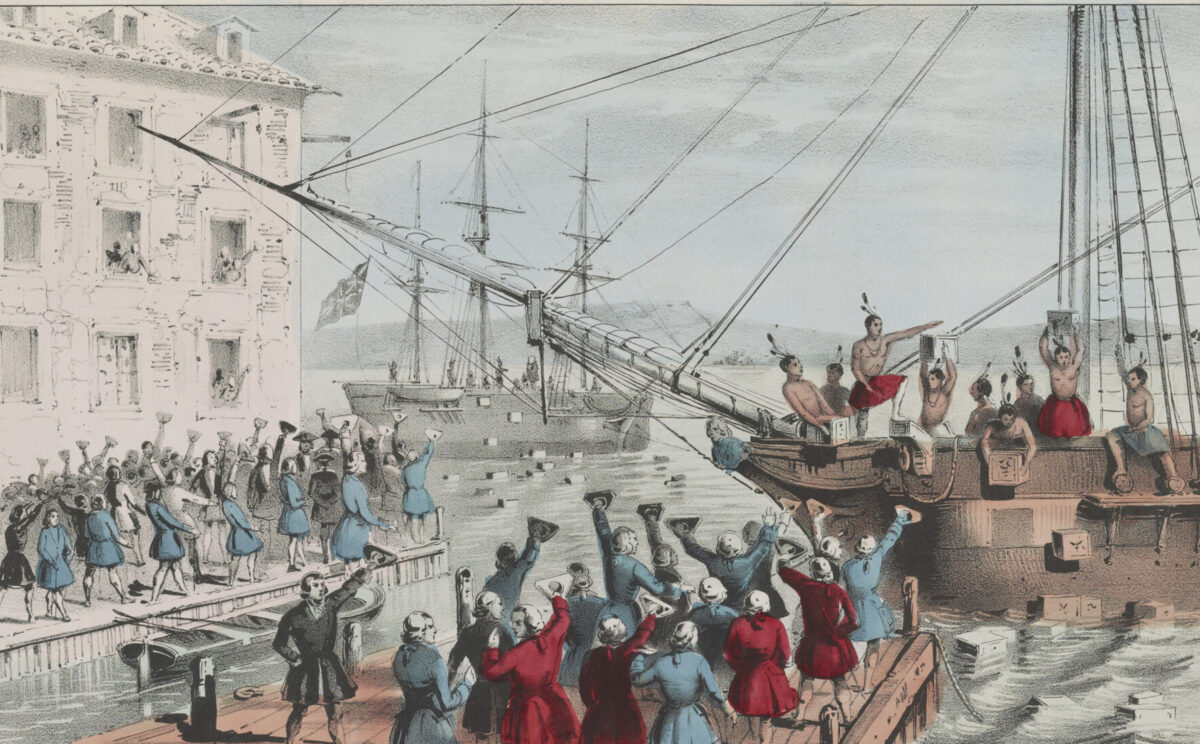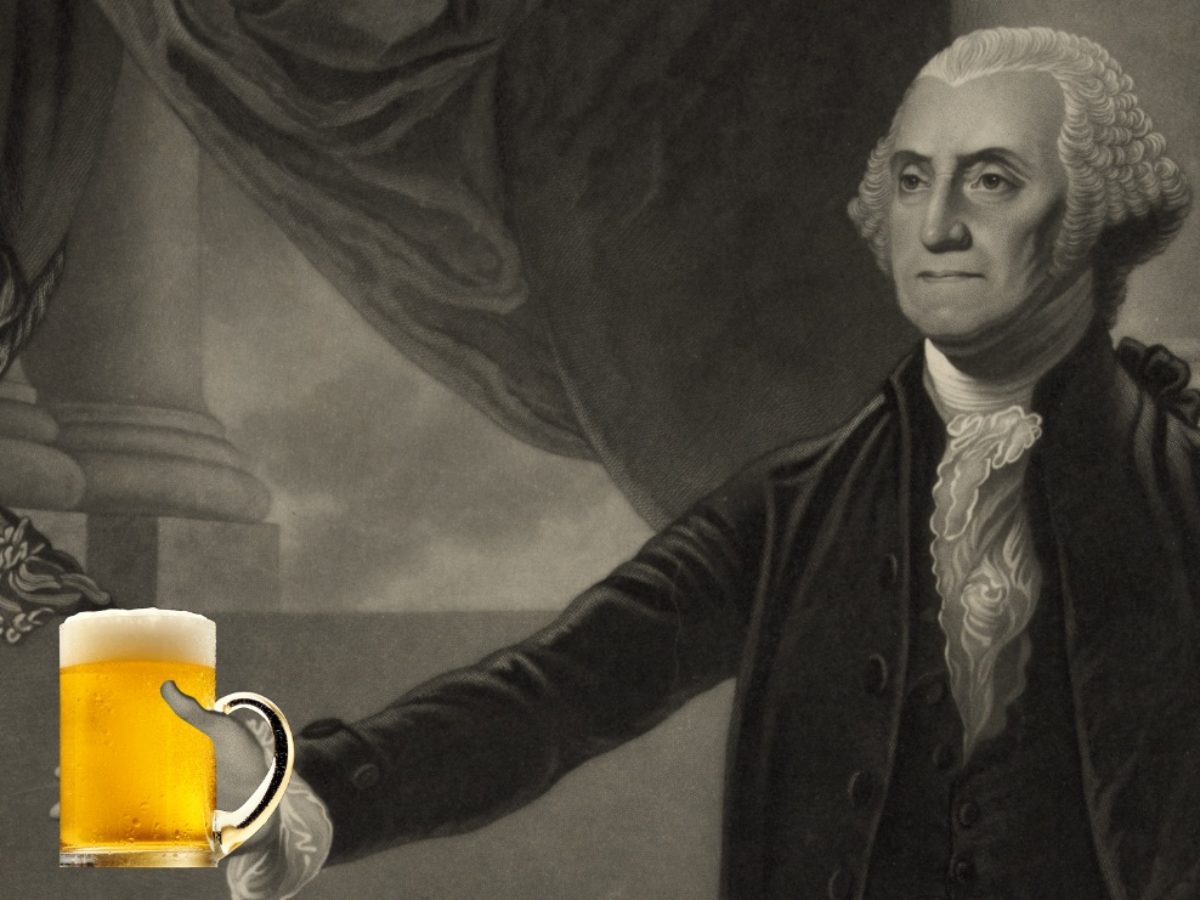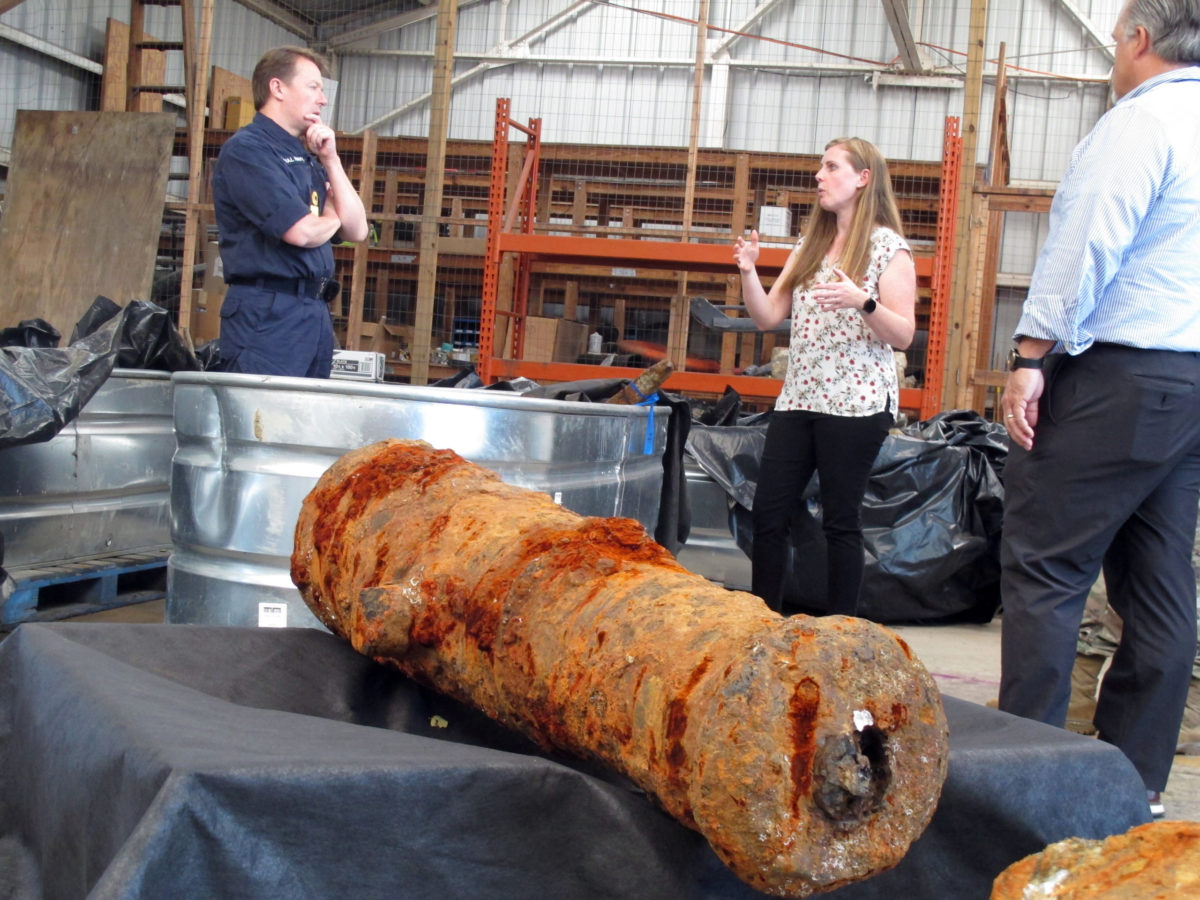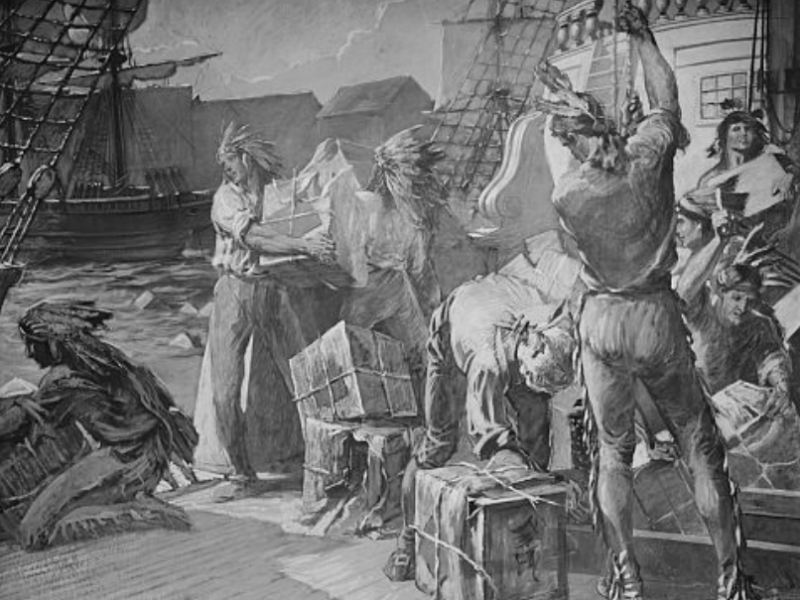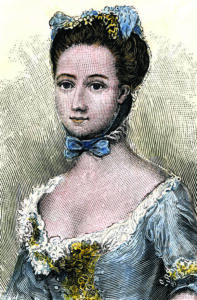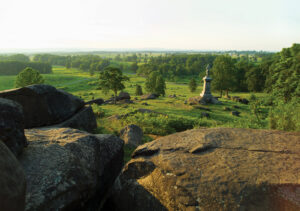John Hicks made it home well after midnight on that chilly December night in 1773. Not wanting to wake his wife—and thus incur her wrath—he quietly entered his house in Cambridge, Mass., gingerly removed his boots and silently crept up to bed.
Recommended for you
The next morning, Elizabeth came downstairs first. Spotting his out-of-place footwear, she quickly surmised that John had sneaked out during the night. When he finally woke up, a suspicious Elizabeth began questioning her husband about his nocturnal activities.
At first, John denied ever leaving the house, but his wife continued her harsh interrogation: “Well, look at your boots standing here. They weren’t here last night when you wore them up to bed. Of course, you were out last night!”
With that, Elizabeth picked up his boots and spotted something falling from them: tea leaves. John then fessed up—he had left the house to join the Sons of Liberty in neighboring Boston as they protested the hated Tea Act of 1773 and assisted in dumping 342 chests of the British Empire’s favorite beverage into the harbor.
Hicks’ involvement in this historical event—marking its 250th anniversary this year—offers intriguing insight into a defining moment that triggered the American Revolution. On Dec. 16, 1773, more than 100 men—some dressed in American Indian outfits—clambered aboard three merchant vessels docked at Griffin’s Wharf in Boston and set in motion actions that led to the “shot heard round the world” at Lexington and Concord nearly two years later.
“The Boston Tea Party was the catalyst that brought about this revolutionary change,” wrote Benjamin Woods Labaree in his eponymous epic about the incident that upended history, first published in 1964. He added, “For three years before the Tea Party, the 13 American colonies shared no common cause, and relations between them and the mother country were relatively calm. Within 18 months after the Tea Party the colonies were united in war against Great Britain.”
John Adams believed the tossing of tea was an earthshaking event. A resident of Braintree (now Quincy), the future president learned about what happened the next day. In his diary, he wrote, “This Destruction of the Tea is so bold, so daring, so firm, intrepid and inflexible, and it must have so important Consequences, and so lasting, that I cant but consider it as an Epocha in History.”
Hicks is believed to be one of the men who protested the Tea Act that night 250 years ago—“believed” because no eyewitness accounts exist naming those who boarded the ships: Dartmouth, Eleanor, and Beaver. The insurgents kept quiet afterward because their defiant act was viewed as treason by the Crown, punishable by hanging.
Stories about those who tossed the tea began emerging more than a quarter-century later after America had already secured its independence. In fact, the protest itself was not referred to as the “Boston Tea Party” in print until 1834, according to historian Alfred F. Young, author of 1999’s “The Shoemaker and the Tea Party: Memory and the American Revolution.” Prior to that, it was known simply as the “destruction of the tea” and was rarely mentioned by early chroniclers because it didn’t fit the narrative of liberty-loving Patriots defending themselves against oppressive English aggressors.
To date, only about 140 people have been identified as participating in the Tea Party. Hicks was one of them—at least according to an article printed in Volume 20 of the “Proceedings of the Cambridge Historical Society” in 1934, which described the encounter between him and his wife. Also thought to be there that cold night were William Breck of Boston, Joseph Dow of Amesbury, Mass., and Michael Jackson of Newton, Mass. Jackson (see sidebar) has only recently been identified as involved in the Boston Tea Party.
The stories of those four men provide a personal view of what happened that evening in Boston. A new effort helps to highlight their histories through a surprising source: their heirs. Developed by the Boston Tea Party Ships and Museum and New England Historic Genealogical Society, a descendants program focuses attention on the bravery of these men as only their proud progeny can tell it.
“John Hicks was a rabble-rouser,” said Mary Ellen Rogan, a descendant of the tea-tossing rebel. “According to what I’ve learned, he was a Patriot while his sons were Loyalists. Neighbors reported hearing loud arguments coming from his home while the family was seated around the dinner table.”
Rogan—along with Erica Hahn of California, Jonathan Lane and John Rando, both of Massachusetts, and John Cox of Connecticut—talked about their historical links to men who stood up for liberty.
A librarian in New Jersey, Rogan discovered her relationship to Hicks some years ago while researching her family’s genealogy. As a child, she learned some ancestors were sea captains from Maine. Deeper digging as an adult revealed an even older connection to New England.
“I discovered we had people in the Revolution and also on the Mayflower,” she said. “When I got to Hicks, I learned he was a tax collector, though not a very good one. I don’t think his heart was in it.”
Like many residents of Boston and surrounding communities, Hicks would have been aware of the mounting dissent over the tea tax imposed by the British. Several meetings and protests were held following the arrival of the first ship laden with crates of Bohea, Congou, Singlo and Hyson tea. Citizens were angered by England’s attempt to institute taxes when the colonies had no representation in Parliament—an act they viewed as tyrannical because of rights stipulated in the Magna Carta of 1215.
In actuality, the Tea Act of 1773 did not include a tax. Parliament tried to sneak through duties from the Townshend Acts of 1766 and 1768, which had been vigorously opposed by the colonies, culminating in the Boston Massacre of 1770. English legislators backed down and repealed the law, only to try to slip it through one more time.
Once again, the colonists were having none of it. In 1773, protests erupted up and down the Atlantic seaboard. Mostly, these remonstrations were peaceful. In New York and Philadelphia, ships were sent back to England without being allowed to unload their consignments. In Charleston, S.C., crates of tea were left to rot on the docks.
In Boston, however, Royal Governor Thomas Hutchinson decided to enforce British sovereignty. He refused to let the merchant ships—owned by colonial traders—to leave without payment of the taxes by a deadline of December 16, 1773.
That evening, the Sons of Liberty held a mass meeting at the Old South Meeting House. Up to 7,000 people gathered outside the Boston church while patriot Samuel Adams attempted to get the governor to rescind his order. When that failed, Adams reportedly said, “This meeting can do nothing further to save the country.”
After the crowd heard that news, someone shouted, “Boston harbor a teapot tonight,” according to Young. It may have been a prearranged signal. Soon, a small group of men in Mohawk dress—signifying American independence to the colonists—started making its way to the waterfront. They were quickly joined by an angry mob, many of whom blackened their faces with soot to avoid being identified.
One piece of the evidence that suggests the Boston Tea Party was planned is a notice that posted around town prior to Sons of Liberty meeting on that eventful eventide. Published by the “Chairman of the Committee for Tarring and Feathering,” the inflammatory message urged Boston citizens to hold accountable “those odious Miscreants and detestable tools” responsible for preventing the tea’s return to England.
“Hold yourselves in Readiness, on the shortest Notice, to give them such a Reception, as such vile Ingrates deserve,” it proclaimed.
Hicks was probably a protester that night—and may have taken extraordinary measures to be one. According to another descendant, he snuck out of his home—not by the front door, but through a second-story window.
“Hicks hated the British; he despised them,” said Erica Hahn, who is also related to the Pilgrims and is a board member of the California Mayflower Society. “Two of his sons were deeply Tory and tried to keep their dad from doing anything they didn’t approve of. Hicks made a ladder of sheets and climbed down from the bedroom to get out of the house without being seen. This is included in several family genealogies and I think it has the ring of truth.”
On his way to Boston Harbor, Hicks might have bumped into Joseph Dow and his wife, Judith, who were visiting the town on December 16. Dow was a shipbuilder in Amesbury, located north of Boston on the New Hampshire border. It appears he was in Boston on business. During the British occupation of the town in 1775–76, Dow may have contracted to do work with the English military.
“He was kept busy and well paid,” claimed “The Book of Dow: Genealogical Memoirs,” written by Robert Piercy Dow in 1929.
Dow’s exact participation is unknown. He might have been swept up in the turmoil on the streets and followed the mob to Griffin’s Wharf, where he at least witnessed crates being hurled into the salty water. Dow later became a Tory and fled to Maine before moving to Canada, where he established a new ship-building business in New Brunswick.
“He had come down to Boston on business and got caught up in this event,” said descendant John Rando, who lives in Gloucester, Mass. “I suspect it was by happenstance. There’s no proof he was part of the Sons of Liberty, who were really the ones stirring the pot.”
He added, “Joseph Dow was at the right place and the right time. He made a different choice after that, but I have relatives who were on the American side. Reuben Dow was a militia captain who fought at Lexington and Concord. He was later wounded at Bunker Hill. I can’t speak for Joseph, but Reuben left behind a wife and family to answer the call of duty. That says a lot.”
In all likelihood, William Breck was an active participant in the Boston Tea Party. The Boston merchant served in the Boston militia, and was a member of the Sons of Liberty and a freemason, some of whom had an active role in planning the protest. He was also associated with patriot Paul Revere, who following the tea toss was dispatched by the Sons of Liberty to New York and Philadelphia to inform them of what happened.
Jonathan Lane learned of his ancestral ties to Breck from his grandmother, Barbara Lane. She was the keeper of the family history—a job she inherited from her grandfather, Charles Edward Benton, a Civil War veteran. They were responsible for collecting documents and details about past relations so future generations would know the role they played in history.
“Her grandfather told her about our ancestors in the American Revolution and she told me about them,” recalled Lane, who is the Revolution 250 coordinator at the Massachusetts Historical Society in Boston, currently gearing up for America’s semiquincentennial in 2026.
“I’m a child of the Bicentennial. I was 10 in 1976 and my grandmother was very keen to make sure I understood about our role in the American Revolution. I have dozens of relatives who fought and supported the war.”
So, did Breck throw tea off the ships in Boston Harbor? Lane is not sure about that. Breck’s whereabouts that night are unknown, but it is thought he attended the gathering at Old South Meeting House and then exercised his right of civil disobedience.
“Breck was actively engaged in the Sons of Liberty, St. Andrew’s Masonic Lodge and one of the local caucuses, which were all involved in protesting the tea tax,” Lane said. “Because of those associations, it is assumed he was there. We know 92,000 pounds of tea were unloaded into the harbor. That was a lot of work for the 140 or so men said to have been on the ships. There were probably many others that we don’t know about.”
One of those who might have been on the ships and possibly wore Native American clothing was Michael Jackson. A forgotten hero of the American Revolution, he led a militia unit as English soldiers retreated from Lexington and Concord, was wounded at the Battle of Bunker Hill. Jackson nearly lost a leg during an amphibious assault on an island in New York Harbor in 1776 and wintered at Valley Forge in 1778 (his wife is believed to have served as a nurse at that cold encampment). He was one of the few men to serve in the Continental Army from its inception in 1775 to its disbanding in 1783, when he held the rank of brevet brigadier general.
Thanks to an elderly aunt, John Cox had been aware of his blood tie to Jackson since he was a child. Her diligent genealogical research was one of the reasons he joined the Litchfield Patriots, a nonprofit organization honoring the residents of his Connecticut town who fought for American independence.
“Her mother was a Jackson and she was devoted to the history of the family,” he recalled. “Over the years, she had collected a treasure trove of information on the Jacksons going back to the Revolution and before. When she knew she was fading, she started passing along to me her collection, which included copies of letters in Boston museums.”
His membership in the Litchfield Patriots brought Cox in contact with Kristin Harris, research coordinator at the Boston Tea Party Ships and Museum. She was in his town last year as part of a delegation placing a marker at the grave of Elisha Horton in commemoration of his role in the historic tea toss.
At that event, Cox spoke to Harris about Jackson and described a letter referring to his ancestor’s involvement in the fabled fracas in Boston Harbor. After further research, she was able to verify that Jackson was indeed there (see sidebar), making the Revolutionary War veteran the latest Tea Party participant discovered.
On December 16, 1773, Jackson lived in Newton, then known as Newtown, which was about 10 miles from the scene of the crime. Because of that distance, it is surmised that the militia leader was already in Boston, probably having learned of the evening’s plans because of his involvement in the Sons of Liberty.
The letter in question was penned by Jackson’s son, Ebenezer, in 1823. The missive to his son Ebenezer Jr., details Michael Jackson’s military service, including how he fought in the French and Indian War, was a lieutenant in the Massachusetts Provincial Regiment, and served in the Continental Army. It also includes this tantalizing sentence: “He was one of those who under a disguise of Indian dress, destroyed the tea in Boston at the commencement of the Revolution.”
With that verification, Cox and his brother were invited to Boston last fall to place a Boston Tea Party marker at Jackson’s grave at Centre Street Cemetery in Newton.
“It was exciting to learn that Jackson had a hand in this,” Cox said. “It’s fun to look back and learn that somebody could go through all that he did.”
Understandably, the descendants of these four men are proud of their ancestors’ accomplishments in the Boston Tea Party and Revolutionary War. Their involvement is a badge of honor for them and their families—a symbol representing a patriotic zeal to sacrifice all for liberty and human rights.
“It’s weird to have this connection to history because of something your ancestor did,” Lane said. “So many people sacrificed so much for this cause. This is what inspires my work with Revolution 250 and inspires me to learn more about the people who participated in the Tea Party. I think it’s really important for us to continue their legacy.”
“I’m thrilled to death to know that my family was there and involved,” Rogan added. “They did what they believed they had to do. I’m glad to be descended from people like that. John Hicks and my other ancestors were thoughtful people who lived by their own code.”
Ironically, Hicks did not get the chance to speak his story like other Boston Tea Party participants did years afterward. He was killed in Cambridge following the Battles of Lexington and Concord on April 19, 1775, when he and other militiamen made a stand against the Red Coats.
Today, the Cambridge Martyrs memorial honors Hicks and four others who died for the Patriot cause. His home—the one where he climbed down a ladder of sheets to join the Boston Tea Party—is preserved on the campus of Harvard University in Cambridge as the Hicks House Library.
“Look at the sheer guts of this guy,” Hahn said. “John Hicks was 58 years old and he hikes off to do this thing. He was so brave because he took such a risk. It just blows my mind.”
Do you think you are descended from a tea-tosser? Learn more about the descendants program at the Boston Tea Party Ships and Museum (which has an actual crate of tea recovered from Boston Harbor) at https://www.bostonteapartyship.com/boston-tea-party-descendants.
historynet magazines
Our 9 best-selling history titles feature in-depth storytelling and iconic imagery to engage and inform on the people, the wars, and the events that shaped America and the world.


